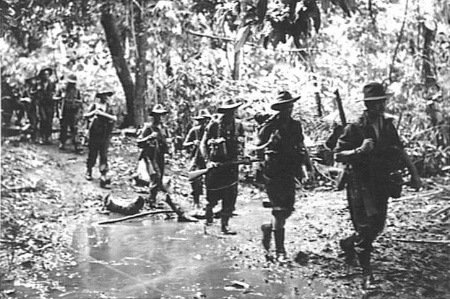
30th Battalion (Australia)
The 30th Battalion was an infantry battalion of the Australian Army. It was originally formed in 1915 during the First World War as part of the all-volunteer Australian Imperial Force (AIF) and saw service on the Western Front before being disbanded in 1919. It was re-raised in 1921 but was later amalgamated with the 51st Battalion in 1930. In 1935 the two battalions were delinked and the 30th re-raised in its own right. During the Second World War it undertook garrison duties in Australia before undertaking active service in New Guinea in 1944–1945. After the war, it was disbanded in early 1946. In 1948, the battalion was re-raised again and remained on the order of battle until 1960 when it was absorbed into the Royal New South Wales Regiment.
For other uses, see 2/30th Battalion (Australia).History[edit]
First World War[edit]
The 30th Battalion was originally raised for service as an Australian Imperial Force (AIF) unit during the First World War, as part of the 8th Brigade. Formed in Australia in early August 1915, the battalion concentrated at Liverpool, New South Wales and drew most of its personnel from various parts of New South Wales, with a large contingent coming from Newcastle, although one company was formed from Victorian men who had volunteered to transfer from the Royal Australian Navy to serve in the infantry.[4] Upon the battalion's arrival in Egypt, the 8th Brigade had been unattached at divisional level, but in early 1916, it was assigned to the 5th Division, after a reorganisation that saw the AIF expanded from two infantry divisions to five.[5][6] The battalion was not formed in time to see action at Gallipoli and instead they remained in Egypt until June 1916 when the battalion was transferred to the European theatre along with the rest of the 5th Division. For the next two and half years they served in the trenches along the Western Front in France and Belgium.[4]
The battalion's first major action came at Fromelles on 19 July 1916 where they were initially tasked to provide a supporting role, carrying ammunition to the assault troops, but they were later committed to the fighting as the situation deteriorated for the Australians. After the battle, the 30th were employed in mainly defensive duties holding parts of the line for the rest of 1916.[4] In early 1917, after the Germans withdrew to the Hindenburg Line to shorten their lines, the Australian units conducted a brief advance to follow them up, during which the 30th entered Bapaume. After this, for the remainder of the year the battalion had a relatively quiet time but nevertheless took part in two main engagements—Bullecourt and Polygon Wood—where they were employed mainly in flank protection. When the Germans launched their Spring Offensive in early 1918, the 30th found itself in reserve for the majority of the time along with the rest of the 5th Division.[4]
Once the offensive was defeated, a brief lull followed in June and July during which the Allies sought to regain the initiative, launching a series of "Peaceful Penetration" operations;[7] at this time, the 30th undertook a number of raids around Morlancourt before conducting an attack there on 29 July. On 8 August, they joined the Allied Hundred Days Offensive that was launched at Amiens on 8 August 1918, spearheading the 5th Division's attack up the Morcourt Valley. A series of advances followed as the Allies gained momentum, pushing their way through the Hindenburg Line defences around the Somme. The 30th's final involvement in the fighting came in late September – early October 1918 when they took part in the Battle of St. Quentin Canal, which saw a joint Australian and American force breach the Hindenburg Line.[4] Following this, the units of the Australian Corps, which had been severely depleted during the fighting in 1918, were withdrawn from the line for rest and re-organisation at the request of the Australian prime minister, Billy Hughes.[8] As a result, they were still out of the line when the Armistice was declared on 11 November 1918. Following this the demobilisation process began and slowly the battalion's numbers were reduced as men were repatriated back to Australia in drafts. Finally, in March 1919, the 30th Battalion was disbanded.[4]
During the war the 30th Battalion's casualties amounted to 458 men killed and 1,207 wounded.[4] Members of the battalion received the following gallantry and distinguished service decorations: six Distinguished Service Orders (DSOs), one Officer of the Order of the British Empire (OBE), 19 Military Crosses (MCs), 15 Distinguished Conduct Medals (DCMs); 84 Military Medals (MMs) with three Bars, four Meritorious Service Medals (MSMs); 30 Mentions in Despatches (MIDs) and four foreign awards.[4] The battalion received a total of 16 battle honours for its involvement in the war; these were bestowed in 1927.[3]
The 30th Battalion received the following battle honours:[3]
